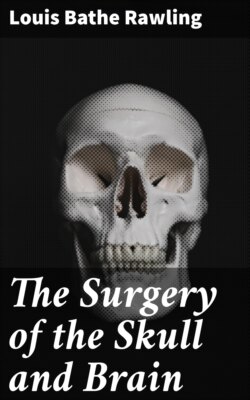Читать книгу The Surgery of the Skull and Brain - Louis Bathe Rawling - Страница 78
На сайте Литреса книга снята с продажи.
Progress of the case.
ОглавлениеWhether the progress of the case be acute or chronic, the ultimate results are much the same. The fluid in the ventricular spaces may be increased up to 1,000 c.c. or more, pressure effects being exerted on the surrounding parts, with the following results:—
A. The soft cerebral substance is slowly but surely compressed, with the result that the sulci on the surface of the brain are more or less obliterated, distinction between the white and grey matter may be lost, the ventricular spaces are enormously dilated, and, in the most marked cases, a mere shell of brain may intervene between the ventricles and the surface of the brain.
This cerebral compression results in the development of two main groups of symptoms, those referable to the general increase in the intraventricular pressure and those due to regional compression.
The more general results are headache, vomiting, optic neuritis and atrophy, slow pulse-rate, somnolence, and coma. The temperature is variable, more commonly rising during the more acute stages of the disease, and falling to normal or subnormal during the quiescent periods.
Localizing features are to be found in squints, inequality of pupils, retraction of the head and neck, dyspnœa, and dysphagia, whilst compression of the cortical motor centres is evidenced by twitchings, convulsions, and spasticity of the limbs. General convulsions are by no means uncommon. Remissions and intermissions of both local and general symptoms are frequently observed, paralyses, for example, fluctuating in depth and character.
B. The bones comprising the vault of the skull become greatly thinned and widely separated from one another, the fontanelles enlarged, and the sutures unduly prominent. The head becomes enlarged in all directions, and its increased weight renders the child incapable of retaining postural control, the head being top-heavy and falling about in all directions.
The bones of the base share in the deformity. The pressure exerted on the orbital plates of the frontal bone force the globe in the downward direction in such a manner that the infra-corneal sclerotic is obscured by the lower lid, whilst the supra-corneal portion is unduly prominent. The bony eminences in the region of the sella turcica are diminished in size, the middle fossa of the skull flattened from side to side, and the posterior fossa from before backwards. In such cases the skull assumes an almost dolicocephalic appearance. In any case, the disproportion between the enlarged skull and diminutive face is a marked feature.[14]
The scalp becomes stretched, hairs are sparse and brittle, and the veins dilated.
